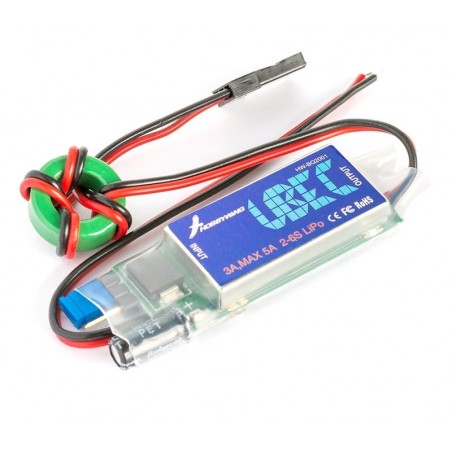


Voltage regulator from the renowned Hobbywing company to supply on-board electronics in RC models.
Technical data:
UBEC 3 A is an impulse DC stabilizer. The manufacturer guarantees proper operation for LIXX 2-6S or NIxx batteries with 5 to 18 cells. The input voltage is lowered to a level suitable for powering the receivers and on-board electronics of RC models. The UBEC load capacity is 3 A permanent, 5 A peak. This makes it suitable for smaller RC helicopters, multiplanes, cars, boats or model airplanes.
It uses an advanced step-down DC converter system with protection against current and thermal overload, operating with efficiency close to 90%.
Small size and light weight for easy use and installation.
2 selectable output voltages (via jumper) suitable for all types of receivers, gyroscopes, servos etc.
LED indicator to indicate UBEC operating status.
Protection against polarity reversal of the supply voltage. If you connect UBEC with the opposite polarity of the supply voltage, UBEC will not work, but because of this, it will not be destroyed. All you need to do is connect it to the correct polarity.
The metal electronics cover and the ferrite ring on the output cable suppress electromagnetic radiation.
Comparison of linear BEC and switched BEC
When powered by a lithium battery with more than 3 cells, the pulsed BEC has a much higher efficiency than the linear BEC.
Traditional linear BEC: eg a 4S LiPo battery has a nominal voltage of 14.8 V; so that the current at 5V BEC output is 1A, the BEC consumption will be at least 1A, so the BEC power consumption will be 14.8V x 1A = 14.8W. But from that we will only use 5V x 1 A = 5 W, so that the efficiency of the linear BEC is only 5 W / 14.8 W = 33.8%, the remainder (14.8 W - 5 W = 9.8 W) is converted into heat uselessly, which causes strong heating of the BEC.
Under the same conditions, the pulsed BEC only draws 0.38A (actual measured value) to provide 1A current at the 5V output, so the BEC power consumption is 14.8V x 0.38A = 5.6A, and the performance The BEC is 5 W / 5.6 W = 89.3%.
Using UBEC
Electric model with OPTO controller: Connect UBEC directly to the drive's battery outputs and connect the UBEC output connector to the battery socket (or other free servo socket) of the receiver.
Electric model with regulator with built-in power stabilizer (BEC): Before connecting the UBEC, disconnect the red wire (+) in the speed control wire to turn off the built-in BEC. Otherwise, the UBEC connection is the same as the OPTO controller.
Combustion engine or sailplane model: Connect the UBEC directly to the battery outputs and connect the UBEC output connector to the battery socket (or other free servo socket) of the receiver.
Tip: To reduce possible UBEC interference in the model, place it at least 5 cm from the receiver and antennas.